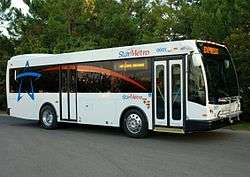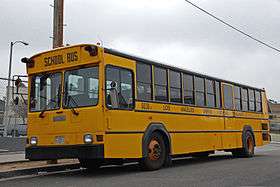Gillig Corporation
|
| |
| Private | |
| Industry | Transit |
| Founded | San Francisco, California, 1890 |
| Founder | Jacob Gillig |
| Headquarters |
25800 Clawiter Road Hayward, California 94545, United States |
Area served | North America |
Key people | David H. Dornsife (Chairman) |
| Products | Heavy-duty low floor transit buses |
| Parent | Henry Crown & Company |
| Website | www.gillig.com |
The Gillig Corporation, formerly Gillig Bros., is an American manufacturer of heavy-duty low-floor transit buses based in Hayward, California. Prior to 1993, Gillig also made school buses.
Gillig is the second largest transit bus manufacturer by volume in North America, behind New Flyer. As of 2013, Gillig had an approximate 31% market share of the combined US and Canadian heavy-duty transit bus manufacturing industry, based on the number of equivalent unit deliveries.
History

In 1890, Jacob Gillig opened a carriage and wagon shop in San Francisco, California. His son, Leo Gillig, joined him in 1896. The original shop was destroyed in the 1906 San Francisco earthquake, but reopened as the Leo Gillig Automobile Works to manufacture bodies for automobiles, hearses, trucks, and buses.
In 1920, Leo's brother Chester Gillig joined him and the company was renamed to Gillig Bros. The same year, the company introduced and patented the "California Top" roof construction style, which consisted of a hard-top roof and sliding windows. In the late 1920s, Gillig starting producing pleasure boats and heavy trucks.
In 1932, the company started bus production with a school bus body; a flat-front (transit-style) school bus was introduced in 1937. In 1938 the company moved to its present location in Hayward, CA.
In 1957, Gillig purchased the Pacific Bus division of Kenworth; by that time, Gillig production was devoted almost entirely towards school buses. In 1959, Gillig pioneered the diesel-powered rear-engined transit style school bus with the release of the C-series Transit Coach. Within five years, the C-Series accounted for three-quarters of all of Gillig sales.
In 1967, Gillig introduced the 743DT-16; with a rated passenger capacity of 97, the 743DT-16 was the highest-capacity school bus ever produced (along with its corresponding Crown Supercoach counterpart). In 1969, Herrick-Pacific Steel purchased Gillig Brothers, renaming it Gillig Corporation.
In 1977, to diversify its product line, Gillig entered transit bus production. The company partnered with West German manufacturer Neoplan to build a series of European-styled transit buses; the buses featured propane-fueled engines as an option. The partnership with Neoplan lasted until 1979.[1]
In 1980, Gillig introduced the Phantom,[2] a heavy-duty transit bus based on their previous round-body school bus platform. A State of California tax-free subsidy helped early sales. Later sales were buoyed by low bids on contracts, and by specializing in serving smaller transit agencies. This strategy proved successful, as the Phantom became one of the longest-lasting transit models. Production of the Transit Coach School Bus ceased in 1982, but Gillig offered a school bus version of the Phantom in 1986,.[3] The Spirit, a late-1980s attempt at a medium-duty bus, experienced poor sales and was discontinued after a few years.
In 1993, Gillig exited school bus production entirely as the Phantom school bus was discontinued after several years of declining sales. In 1997, Gillig entered the low-floor bus market with the Advantage (originally called H2000LF, and is currently called the "Low Floor"). Like the Phantom, the Low Floor was first purchased largely by rental car companies for use at airport facilities, but transit sales increased as the model matured.
On August 1, 2008, Gillig became a Henry Crown company under CC Industries, Inc. CC Industries operated Gillig in the same location with the current management team.[4] After a 28-year production run, the Phantom ended production as high-floor buses had fallen out of favor during the late 1990s and early 2000s.

Alternative fuels
In 1992, Gillig began producing an LNG fueled version of the Phantom in an attempt to produce a low-emissions transit bus, but later discontinued it. The only remaining LNG Phantoms currently operate shuttle service at Los Angeles International Airport and Dallas/Fort Worth International Airport.
In 1996, Gillig introduced a diesel-electric hybrid powered Phantom, which they produced until 2006. The Low Floor bus is now offered in a hybrid powered version, as the company continues to focus efforts on "clean diesel" technology.
In September 2011, Gillig introduced an alternative fuel BRT model with CNG propulsion—their first CNG-powered bus produced and first production natural gas buses since 1998. Long Beach Transit purchased a pilot bus in 2011, and placed an order for 63 more in 2012.
Though Gillig has never built an electric trolley bus (ETB), in 2001-2002 the company supplied 100 body-chassis shells to Seattle's King County Metro Transit for the latter to equip as trolley buses. More than just shells, Gillig shipped these Phantom buses in fairly complete form, including interior fittings such as seats—lacking only propulsion equipment and other ETB-only features such as trolley poles. The Seattle transit agency, Metro, removed the propulsion packages from its old fleet of 1979-built AM General trolley coaches (G.E. traction motor, Randtronics chopper control, and electronic card cage),[5] which the Gillig vehicles were purchased to replace, and shipped them to Alstom (in New York) for refurbishment.[6] After Alstom refurbished the propulsion equipment, Metro installed it in the new Gillig Phantom bodies, along with Vossloh-Kiepe pneumatically operated fiberglass trolley poles.[6]
Products
| Gillig Product Lines (Current/Discontinued) | ||||
|---|---|---|---|---|
| Model Name | Production | Configuration | Length | Notes |
| Gillig Low Floor
|
1996–present | Low-floor transit bus | 29, 35, 40 ft (8.8, 10.7, 12.2 m) |
|
| Gillig BRT
|
2004–present | Low-floor transit bus | 31, 37, 41 ft (9.4, 11.3, 12.5 m) |
|
| Gillig Phantom
|
1980-2008 | High-floor transit bus | 30, 35, 40 ft (9.1, 10.7, 12.2 m) |
|
| Gillig Spirit | mid-late 1980s | High-floor transit bus | 28 ft (8.5 m) | A 28-foot (8.5 m) medium-duty bus offered as lower-cost alternative to the 30-foot-long (9.1 m) Phantom. |
| Gillig-Neoplan | 1977-1979 | High floor transit bus | 30, 35 ft (9.1, 10.7 m) |
|
| Gillig Transit Coach School Bus
|
1940-1982 | School Bus | 28–40 ft (8.5–12.2 m) |
|
| Gillig Phantom School Bus
|
1986-1993 | School Bus (rear-engine) | 37, 40 ft (11.3, 12.2 m) | 96" wide version of the Phantom redesigned to school bus specifications as a successor to the Transit Coach. |
References
- Gillig, LLC, gillig.com, retrieved on 2006-12-25
- Transit Coach / Pacific SchoolCoach Online Museum, gilligcoaches.net, retrieved on 2006-12-25, archived from the original at http://www.gilligcoaches.net/ archive date: 2006-12-30
- Leo Gillig Automobile Works - Gillig Brothers, coachbuilt.com, retrieved on 2006-12-25
- A Brief History of Hall-Scott, northern.edu, retrieved on 2006-12-26
- GM Brings Clean Mass Transit to Environmental Conference, allisontransmission.com, retrieved on 2006-12-25
- Stauss, Ed (1988). The Bus World Encyclopedia of Buses, Woodland Hills, CA: Stauss Publications. ISBN 0-9619830-0-0
Notes
- ↑ Stauss, Ed (1988), 66.
- ↑ Stauss, Ed (1988), 67.
- ↑ Stauss, Ed (1988), 68.
- ↑ http://www.metro-magazine.com/News/Story/2008/08/Gillig-Corp-under-new-ownership.aspx
- ↑ Metro Employee Historic Vehicle Association - Bus #1008, mehva.org, retrieved on 2007-11-18
- 1 2 "Metro Transit Bus facts and figures - Gillig Trolley Bus". King County Metro. September 2002. Retrieved 2009-12-04.
External links
| Wikimedia Commons has media related to Gillig Corporation. |




.jpg)


